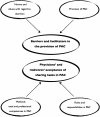Barriers and facilitators in the provision of post-abortion care at district level in central Uganda - a qualitative study focusing on task sharing between physicians and midwives
- PMID: 24447321
- PMCID: PMC3903434
- DOI: 10.1186/1472-6963-14-28
Barriers and facilitators in the provision of post-abortion care at district level in central Uganda - a qualitative study focusing on task sharing between physicians and midwives
Abstract
Background: Abortion is restricted in Uganda, and poor access to contraceptive methods result in unwanted pregnancies. This leaves women no other choice than unsafe abortion, thus placing a great burden on the Ugandan health system and making unsafe abortion one of the major contributors to maternal mortality and morbidity in Uganda. The existing sexual and reproductive health policy in Uganda supports the sharing of tasks in post-abortion care. This task sharing is taking place as a pragmatic response to the increased workload. This study aims to explore physicians' and midwives' perception of post-abortion care with regard to professional competences, methods, contraceptive counselling and task shifting/sharing in post-abortion care.
Methods: In-depth interviews (n = 27) with health care providers of post-abortion care were conducted in seven health facilities in the Central Region of Uganda. The data were organized using thematic analysis with an inductive approach.
Results: Post-abortion care was perceived as necessary, albeit controversial and sometimes difficult to provide. Together with poor conditions post-abortion care provoked frustration especially among midwives. Task sharing was generally taking place and midwives were identified as the main providers, although they would rarely have the proper training in post-abortion care. Additionally, midwives were sometimes forced to provide services outside their defined task area, due to the absence of doctors. Different uterine evacuation skills were recognized although few providers knew of misoprostol as a method for post-abortion care. An overall need for further training in post-abortion care was identified.
Conclusions: Task sharing is taking place, but providers lack the relevant skills for the provision of quality care. For post-abortion care to improve, task sharing needs to be scaled up and in-service training for both doctors and midwives needs to be provided. Post-abortion care should further be included in the educational curricula of nurses and midwives. Scaled-up task sharing in post-abortion care, along with misoprostol use for uterine evacuation would provide a systematic approach to improving the quality of care and accessibility of services, with the aim of reducing abortion-related mortality and morbidity in Uganda.
Figures
References
-
- World Health Organizaton. Unsafe abortion: global and regional estimates of the incidence of unsafe abortion and associated mortality in 2008. 6. Geneva, Switzerland: World Health Organization; 2011.
-
- Prada E, Mirembe F, Ahmed FH, Nalwadda R, Kiggundu C. Abortion and postabortion care in Uganda: a report from health care professionals and health facilities. New York: The Alan Guttmacher Institute; 2005.
-
- World Health Organizaton. Safe abortion: technical and policy guidance for health systems. 2. Geneva, Switzerland: World Health Organization; 2012. - PubMed
Publication types
MeSH terms
LinkOut - more resources
Full Text Sources
Other Literature Sources
Medical


